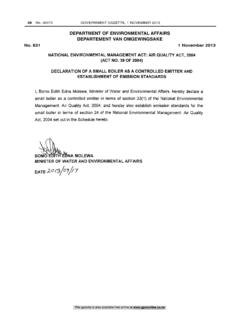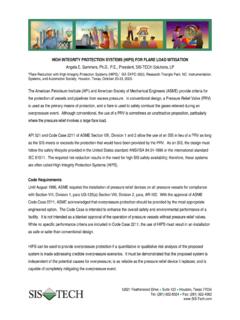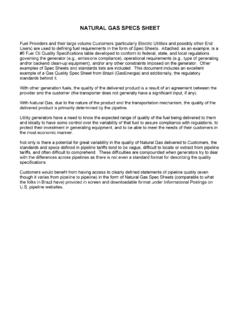Transcription of AXIC APPLICATION REPORT
1 axic APPLICATION REPORT PHOTORESIST STRIPPING 10 by Jozef Brcka, AXJC, Santa Clara, CaliftJmia T HERE ARE MANY applications OF PLASMA PROCESSES to organic materials. These include surface property modifications to improve wetting, dyeing, printing, and adhesion properties of polymeric materials, as well as, plasma ashing to remove "organic smear" that results from mechanical drilling of printed circuit boards [ 1]. The original and still most widely applied use of plasma processing to the electronics industry is photoresist stripping, which is the removal of polymeric photoresists following lithography, etching and deposition processes m semiconductor manufacturing.
2 A competing photoresist stripping technology is wet stripping, which is the removal of photoresists with chemical solutions. However, there are many advantages to dry, plasma stripping over wet chemical stripping as outlined in Table 1. A generalized diagram of thin film patterning is shown in Fig. 1. As can be seen, plasma treatments are used at several steps - cleaning and activation of the surface prior to thin-film deposition, . dry development, plasma descumming, and resist stripping. This APPLICATION note deals with the last two processes -plasma descumming and plasma stripping.
3 Photoresists are photosensitive organic polymers used for device patterning during IC fabrication. The photoresist is exposed to light though a mask and subsequently developed, which results in a pattern of areas free of photoresist. The exposed areas are etched or coated with another layer, while the unexposed, resist protected areas are not affected. Following the process step, the photoresist has to be removed (stripped) to prepare the wafer for the next fabrication step. Plasma activated oxygen atoms react vigorously at room temperature with photoresists (low temperature ashing).
4 The oxidation products,' CO, COz, and water vapor are evacuated from the chamber with unreacted feed gas (see Fig. 2). The objective in plasma stripping is the rapid removal of resists, without etching or otherwise damaging the substrate or underlying thin-film structure. Stripping rates can vary from I 00 nm/min. up to several microns/min. Strip rates primarily depend on the oxygen content of the feed gas, which is controlled by flow rate of oxygen gas into the reactor chamber and chamber pressure.
5 The addition of "impurity gases" to molecular oxygen will enhance the production of oxygen atoms in plasma. For example, small additions of CF4 or SF6 can increase stripping rates as the result of increased oxygen radicals and increased initiation rate via indiscriminate abstraction of hydrogen from the photoresist by highly reactive fluorine atoms in the plasma. Hence, etch rates can be enhanced further by optimizing CF J02 ratios of the feed gas mixture. In some cases, hydrogen gas is added to the feed gas mix to improve anisotropy.
6 However, this will slow the etch rate. axic APPLICATION REPORT NO. 10 2 TABLE 1 c f dd omparason o wet an try resast stnppanJ!. Disadvantages of wet resist stripping Advantages of dry (or plasma) stripping handling and disposal of large volumes of either using a gas medium - usually oxygen hydrocarbon solvents or strongly oxidizing acids non-toxic, non-corrosive safety and technical requirements to handle toxic and low-temperature processing corrosive liquids control of process handling and disposal of large volumes of deionized water low price for medium can leave traces of photoresist on the wafer environmental contamination waste disposal less environmental impact simple handling and manipulation more cost/materials/energy/work effective IIE818 TMMK OPTICAL OR UV EXPOSITION jJ]].
7 ORIGIN MASK --y Simplified process Kheme for typical patterning of a thin layer using a lithographic procedure with positive resist. Plasma treatment steps are indicated. Another variable effecting plasma stripping rates is temperature. Strip rates increase exponentially relative to temperature. Surface bombardment by photons, electrons, and ions may result in surface heating of the photoresist resulting in surface temperatures of approximately 100 degrees Celsius. At temperatures above 150 degrees Celsius many photoresists will begin to decompose.
8 Thus, the APPLICATION of external sources of heat can greatly increase plasma stripping rates [2,3]. In addition to contributing to heat production, ion bombardment can physically break surface bonds generating radical species at the resist surface and product desorption. Of course, resist type will also contribute the determination of the strip rate. Some are more difficult to remove than others. Plasma reactor configurations are selected based on process needs. A variety of configurations have been applied to plasma stripping (see Table 2).
9 A reactor with parallel plate electrodes (Fig. 2) provides good removal uniformity as the result of good thermal contact between the wafer and the electrode. A MHz RF generator is typically used in plasma stripping and with axic APPLICATION REPORT NO. 10 placement of the wafer on the grounded parallel electrode, ion bombardment is reduced. Plasma generation at lower frequencies (40 -400 kHz) will result m higher surface temperature from TABLE2 Typical process parameters m res1st stripping. 3 increased ion generation and bombardment, but should not be used in processes that are sensitive to ion bombardment.
10 FREQUENCY AND PRESSURE TEMPERATURE ETCH RATE RESIST REACTOR TYPE (mtorr) rf, barrel 500-1000 rf, barrel 800 rf, parallel plate (diode) 500-1000 rf, RIE 10.,150 rf, RIE 75 microwave, downstream 1 OfJ0-5000 Ion bombardment can be completely eliminated in reactors configured with a cage electrode in combination with a Faraday cup (perforated cylinder, Fig. 3), or a downstream (afterglow) reactor. Downstream reactors utilize microwave excitation ( GHz). In some special instances Reactive Ion Etch (RIE) processes have been enhanced with magnetic fields.


